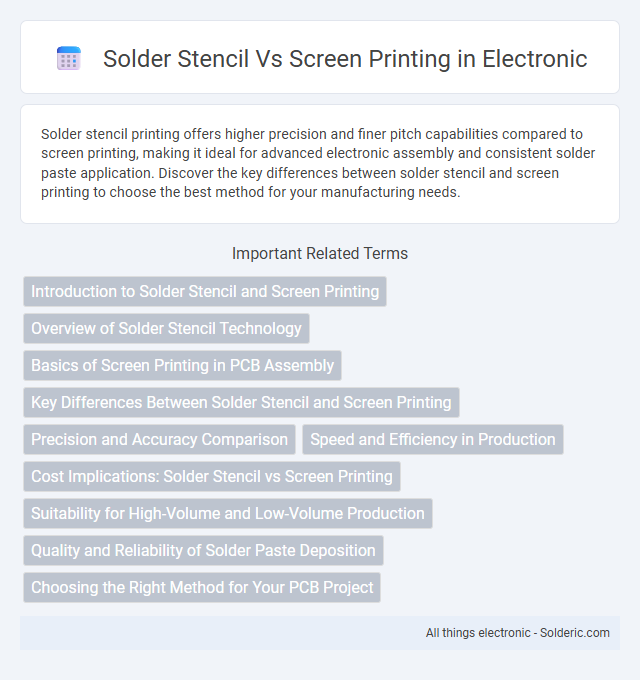Solder stencil printing offers higher precision and finer pitch capabilities compared to screen printing, making it ideal for advanced electronic assembly and consistent solder paste application. Discover the key differences between solder stencil and screen printing to choose the best method for your manufacturing needs.
Comparison Table
| Aspect | Solder Stencil | Screen Printing |
|---|---|---|
| Purpose | Applies solder paste on PCB pads for SMT assembly | Applies solder paste or ink on PCB pads; also used for other coatings |
| Material | Metal sheet (usually stainless steel or nickel) | Mesh screen made of polyester or metal |
| Precision | High precision for fine-pitch components | Lower precision compared to stencils |
| Thickness | Typically 0.1mm to 0.15mm | Same as stencil but mesh affects thickness uniformity |
| Durability | Reusable; long lifespan with care | Less durable; screen may degrade after multiple uses |
| Cost | Higher initial cost; cost-effective for large volumes | Lower initial cost; more cost-effective for small runs or prototyping |
| Setup Time | Longer setup and fabrication time | Faster setup, especially for simple designs |
| Application Speed | Fast and consistent paste application | Slower due to manual or semi-automated process |
| Common Use | Mass production SMT assembly | Small batches, prototyping, and non-PCB uses |
Introduction to Solder Stencil and Screen Printing
Solder stencils are precision-engineered metal sheets used to apply solder paste accurately onto printed circuit boards (PCBs) before component placement. Screen printing involves using a mesh screen to transfer solder paste onto PCB pads through a patterned stencil, offering flexibility for various paste viscosities and board designs. Both techniques serve to ensure precise solder paste deposition, crucial for reliable surface-mount technology (SMT) assembly and quality electronic manufacturing.
Overview of Solder Stencil Technology
Solder stencil technology uses thin metal sheets, often stainless steel or polyimide, with laser-cut apertures that precisely deposit solder paste onto PCB pads. This method ensures high accuracy and repeatability, critical for fine-pitch components in modern electronics manufacturing. Your solder paste application benefits from consistent thickness and volume, improving overall assembly quality compared to traditional screen printing techniques.
Basics of Screen Printing in PCB Assembly
Screen printing in PCB assembly involves applying solder paste through a mesh screen to deposit precise amounts onto the board pads, ensuring consistent and accurate component placement. This method offers excellent repeatability and is suitable for high-volume production, making it ideal for surface mount technology (SMT) applications. Your choice between solder stencil and screen printing should consider factors like pad size, solder paste viscosity, and production scale to optimize assembly quality and efficiency.
Key Differences Between Solder Stencil and Screen Printing
Solder stencil and screen printing are both essential techniques in PCB assembly, but they serve different purposes and involve distinct processes. Solder stencils apply precise solder paste deposits onto specific pads using a thin metal sheet with laser-cut apertures, ensuring accuracy for component placement. Screen printing, on the other hand, generally involves applying solder paste over larger areas through a mesh screen, which is less precise but faster for high-volume production, making your choice dependent on the required precision and production scale.
Precision and Accuracy Comparison
Solder stencils offer higher precision and accuracy compared to screen printing due to their ability to deposit solder paste with tighter tolerances and consistent thickness on PCB pads. The laser-cut apertures in solder stencils ensure precise alignment and uniform paste volume, reducing solder bridging and defects. Your manufacturing process benefits from enhanced repeatability and finer feature resolution when using solder stencils over traditional screen printing methods.
Speed and Efficiency in Production
Solder stencil printing offers faster setup and higher precision, significantly improving speed and efficiency in electronic PCB assembly compared to traditional screen printing. Its ability to deposit consistent solder paste layers reduces rework and material waste, enhancing overall production throughput. Optimizing your manufacturing process with solder stencil technology can lead to quicker turnaround times and cost savings.
Cost Implications: Solder Stencil vs Screen Printing
Solder stencils generally incur higher initial costs due to precision manufacturing and materials, but they offer long-term savings by reducing solder waste and increasing placement accuracy. Screen printing involves lower upfront expenses but may lead to higher operational costs from frequent screen replacements and increased material consumption. Evaluating production volume and precision requirements is crucial for determining the most cost-effective method between solder stencil and screen printing.
Suitability for High-Volume and Low-Volume Production
Solder stencil printing is highly suitable for high-volume production due to its precision, repeatability, and speed, enabling consistent solder paste application on printed circuit boards (PCBs). Screen printing is more adaptable for low-volume or prototype runs because of its lower setup cost and greater flexibility in handling different paste types and PCB sizes. Both methods impact yield and efficiency differently, with stencil printing favored in mass production environments and screen printing preferred for customization and frequent design changes.
Quality and Reliability of Solder Paste Deposition
Solder stencil offers precise and consistent solder paste deposition, ensuring high-quality joints with minimal defects due to its rigid metal frame and fine apertures. Screen printing provides faster paste application but may result in uneven thickness and reduced reliability, especially in fine-pitch components or complex PCB layouts. Choosing a solder stencil optimizes Your assembly's solder joint quality and long-term reliability, critical for advanced electronics manufacturing.
Choosing the Right Method for Your PCB Project
Choosing between solder stencil and screen printing for your PCB project depends on factors like production volume, precision, and complexity. Solder stencils offer high accuracy for precise paste application in complex, low-to-medium volume projects, while screen printing suits high-volume manufacturing with faster throughput and cost efficiency. Your decision should align with the specific requirements of your PCB design and assembly process to ensure optimal solder paste deposition.
Solder stencil vs screen printing Infographic

 solderic.com
solderic.com